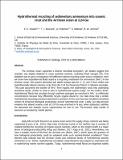Files in this item
Hydrothermal recycling of sedimentary ammonium into oceanic crust and the Archean ocean at 3.24 Ga
Item metadata
| dc.contributor.author | Stueeken, Eva E. | |
| dc.contributor.author | Boocock, Toby J. | |
| dc.contributor.author | Robinson, Abigail | |
| dc.contributor.author | Mikhail, Sami | |
| dc.contributor.author | Johnson, Benjamin | |
| dc.date.accessioned | 2021-04-09T09:30:12Z | |
| dc.date.available | 2021-04-09T09:30:12Z | |
| dc.date.issued | 2021-07-01 | |
| dc.identifier | 273064655 | |
| dc.identifier | c7bcbda7-9d0f-4867-a3c8-a015e4db5bd4 | |
| dc.identifier | 000672235900005 | |
| dc.identifier | 85105935048 | |
| dc.identifier | 000672235900005 | |
| dc.identifier.citation | Stueeken , E E , Boocock , T J , Robinson , A , Mikhail , S & Johnson , B 2021 , ' Hydrothermal recycling of sedimentary ammonium into oceanic crust and the Archean ocean at 3.24 Ga ' , Geology , vol. 49 , no. 7 , pp. 822-826 . https://doi.org/10.1130/G48844.1 | en |
| dc.identifier.issn | 0091-7613 | |
| dc.identifier.other | ORCID: /0000-0001-5276-0229/work/92020112 | |
| dc.identifier.other | ORCID: /0000-0001-6861-2490/work/92020169 | |
| dc.identifier.uri | https://hdl.handle.net/10023/22993 | |
| dc.description | Funding was provided by a Natural Environment Research Council studentship (grant NE/R012253/1) to T.J. Boocock, and a National Science Foundation grant (grant EARPF 1725784) and an American Philosophical Society Lewis and Clark Grant, both to B.W. Johnson. | en |
| dc.description.abstract | The Archean ocean supported a diverse microbial ecosystem, yet studies suggest that seawater was largely depleted in many essential nutrients, including fixed nitrogen. This depletion was in part a consequence of inefficient nutrient recycling under anoxic conditions. Here, we show how hydrothermal fluids acted as a recycling mechanism for ammonium (NH4+) in the Archean ocean. We present elemental and stable isotope data for carbon, nitrogen, and sulfur from shales and hydrothermally altered volcanic rocks from the 3.24 Ga Panorama district in Western Australia. This suite documents the transfer of NH4+ from organic-rich sedimentary rocks into underlying sericitized dacite, similar to what is seen in hydrothermal systems today. On modern Earth, hydrothermal fluids that circulate through sediment packages are enriched in NH4+ to millimolar concentrations because they efficiently recycle organic-bound N. Our data show that a similar hydrothermal recycling process dates back to at least 3.24 Ga, and it may have resulted in localized centers of enhanced biological productivity around hydrothermal vents. Last, our data provide evidence that altered oceanic crust at 3.24 Ga was enriched in nitrogen, and, when subducted, it satisfies the elemental and isotopic source requirements for a low-N, but 15N-enriched, deep mantle nitrogen reservoir as sampled by mantle plumes. | |
| dc.format.extent | 5 | |
| dc.format.extent | 749083 | |
| dc.language.iso | eng | |
| dc.relation.ispartof | Geology | en |
| dc.subject | GE Environmental Sciences | en |
| dc.subject | T-NDAS | en |
| dc.subject.lcc | GE | en |
| dc.title | Hydrothermal recycling of sedimentary ammonium into oceanic crust and the Archean ocean at 3.24 Ga | en |
| dc.type | Journal article | en |
| dc.contributor.institution | University of St Andrews. School of Earth & Environmental Sciences | en |
| dc.contributor.institution | University of St Andrews. St Andrews Centre for Exoplanet Science | en |
| dc.contributor.institution | University of St Andrews. St Andrews Isotope Geochemistry | en |
| dc.identifier.doi | 10.1130/G48844.1 | |
| dc.description.status | Peer reviewed | en |
| dc.date.embargoedUntil | 2021-04-08 |
This item appears in the following Collection(s)
Items in the St Andrews Research Repository are protected by copyright, with all rights reserved, unless otherwise indicated.

